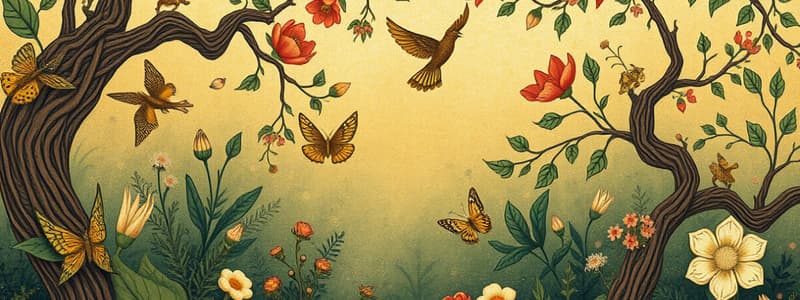Podcast
Questions and Answers
What is interdependence in ecosystems?
What is interdependence in ecosystems?
No species can survive by itself; each is dependent on many other species.
What is coevolution?
What is coevolution?
The evolution of two or more species that interact with each other in a mutually dependent way.
What do food chains and food webs illustrate?
What do food chains and food webs illustrate?
Ongoing relationships between organisms and interdependence within an ecosystem.
Energy flows in multiple directions through an ecosystem.
Energy flows in multiple directions through an ecosystem.
What are producers?
What are producers?
What is the role of decomposers in an ecosystem?
What is the role of decomposers in an ecosystem?
Which of the following are types of symbiotic relationships?
Which of the following are types of symbiotic relationships?
What is an example of mutualism?
What is an example of mutualism?
What is resource partitioning?
What is resource partitioning?
Match the following relationships with their type.
Match the following relationships with their type.
How does competition affect species population sizes?
How does competition affect species population sizes?
What is a niche?
What is a niche?
The ecological niche demonstrates the __________ of environmental change that a species can tolerate.
The ecological niche demonstrates the __________ of environmental change that a species can tolerate.
What is an example of a generalist species?
What is an example of a generalist species?
What is an example of a specialist species?
What is an example of a specialist species?
Flashcards are hidden until you start studying
Study Notes
Interdependence
- Every species relies on others for survival, fostering connections in ecosystems.
- Coevolution occurs when species evolve in response to each other, exemplified by predator-prey relationships.
Food Chains, Webs, and Pyramids
- Food chains illustrate the linear path of energy transfer from producers to consumers.
- Food webs show complex interconnections, highlighting that most consumers have diverse diets and share resources.
- Energy flows unidirectionally, necessitating a continuous supply; nutrients are recycled through biogeochemical cycles (e.g., oxygen, water, carbon, phosphate).
- Producers (autotrophs) create food through photosynthesis or chemosynthesis, while consumers (heterotrophs) consume other organisms.
Trophic Levels
- Producers initiate the food chain, followed by primary, secondary, and tertiary consumers.
- Decomposers recycle nutrients, vital for maintaining fertile soils.
- Energy pyramids depict energy loss at each trophic level, with roughly 10% transferred and 90% used in life processes or lost as heat.
Types of Ecological Pyramids
- Pyramid of biomass: compares dry mass of organisms, can be inverted if low biomass supports high consumer biomass.
- Pyramid of numbers: indicates the actual number of organisms per trophic level; shapes can vary based on ecosystem dynamics.
Predator-Prey Interactions
- Predators control prey populations, contributing to cycles that maintain balanced ecosystems.
- Predator-prey dynamics create population fluctuations: increased predator numbers lead to decreased prey populations, allowing prey recovery followed by predator population increase.
Symbiosis
- Symbiotic relationships illustrate interdependence among species, categorized as:
- Commensalism: One species benefits while the other is unaffected (+/n).
- Mutualism: Both species benefit (++).
- Parasitism: One species benefits at the expense of the other (+/-).
Competition
- Competition arises when species vie for limited resources, leading to specialization and resource partitioning.
- Interspecific competition occurs between different species, while intraspecific competition occurs within a single species.
Ecological Niche
- An organism's niche encompasses its role, including dietary habits, predator relationships, reproduction, and environmental tolerances.
- Niche flexibility can lead to changes throughout a species' life cycle.
Range of Tolerance
- Species possess a range of tolerance which determines the breadth of their ecological niche—generalists have broad tolerances, while specialists are limited to specific conditions.
Resource Partitioning
- Coexisting species may divide resources to minimize competition, leading to differentiated niches.
- Examples include sharing tree resources by feeding at different heights or nesting preferences.
Studying That Suits You
Use AI to generate personalized quizzes and flashcards to suit your learning preferences.



